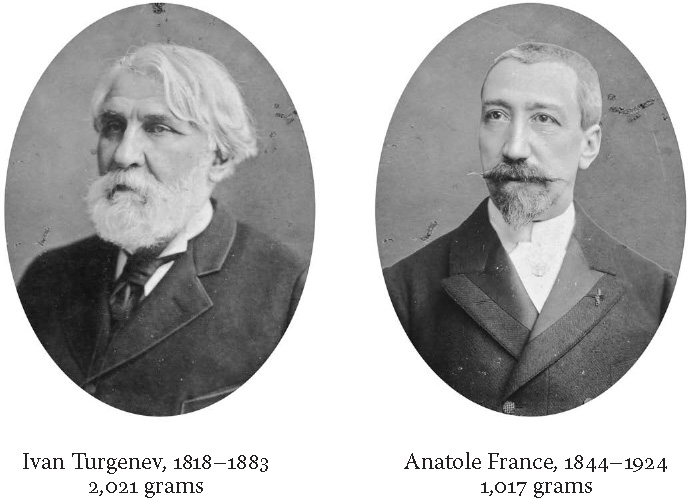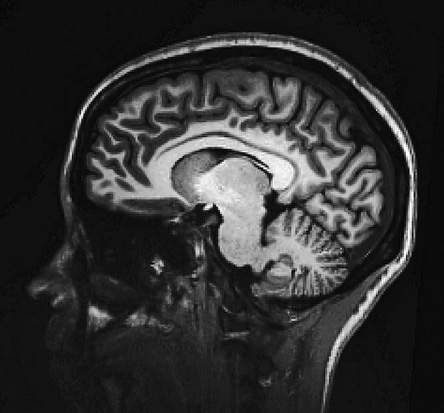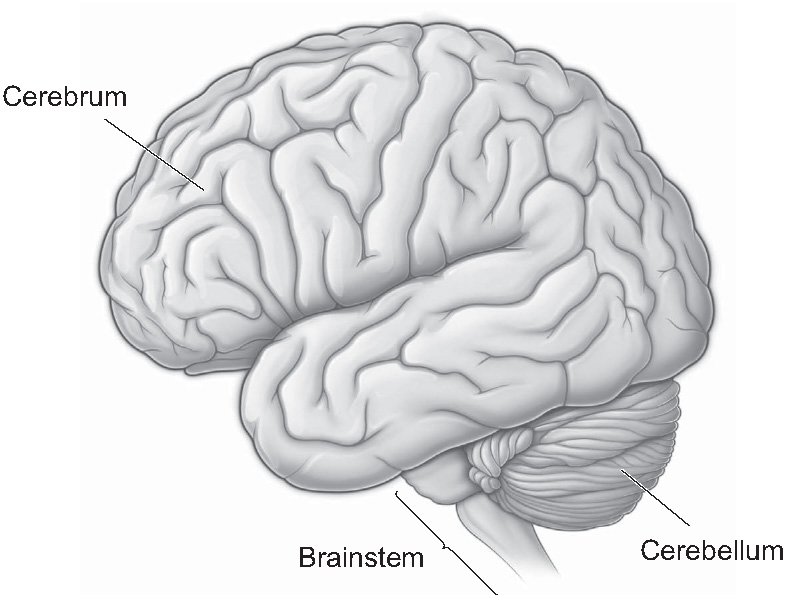Connectome (3 page)
Authors: Sebastian Seung

In Part IV, I explore how this will be done. We are already starting to develop technologies for finding connectomes, and I'll describe the cutting-edge machines that will soon be hard at work in labs around the world. Once we find connectomes, what will we do with them? First, we'll use them to carve the brain into regions, aiding the work of neo-phrenologists. And we'll divide the enormous number of neurons into types, much as botanists classify trees into species. This will dovetail with the genomic approach to neuroscience, because genes exert much of their influence on the brain by controlling how neuron types wire up with each other.
Connectomes are like vast books written in letters that we barely see, in a language that we do not yet comprehend. Once our technologies make the writing visible, the next challenge will be to understand what it means. We'll learn to decode what is written in connectomes by attempting to read memories from them. This endeavor will at long last provide a conclusive test of connectionist theories.
But it won't be enough to find a single connectome. We will want to find many connectomes and compare them, to understand why one mind differs from another, and why a single mind changes over time. We'll hunt for
connectopathies,
abnormal patterns of neural connectivity that might underlie mental disorders such as autism and schizophrenia. And we'll look for the effects of learning on connectomes.
Armed with this knowledge, we will develop new methods of changing connectomes. The most effective way at present is the traditional one: training our behaviors and thoughts. But learning regimens will become more powerful when supplemented by molecular interventions that promote the four R's of connectome change.
The new science of connectomics will not be established overnight. Today we can only see the beginning of the road, and the many barriers that lie in the way. Nevertheless, over the coming decades, the march of our technologies and the understanding that they enable will be inexorable.
Connectomes will come to dominate our thinking about what it means to be human, so Part V concludes by taking the science to its logical extreme. The movement known as transhumanism has developed elaborate schemes for transcending the human condition, but are the odds in their favor? Does the ambition of cryonics to freeze the dead and eventually resurrect them have any chance of succeeding? And what about the ultimate cyber-fantasy of uploading, of living happily ever after as a computer simulation, unencumbered by a body or a brain? I will attempt to extract some concrete scientific claims from these hopes and propose how to test them empirically using connectomics.
But let's not entertain such heady thoughts about the afterlife just yet. Let's begin by thinking about this life. In particular, let's start with the question mentioned earlier, the one that everyone has thought about at some point: Why are people different?
1. Genius and Madness
In 1924
ANATOLE FRANCE
died near Tours, a city on the Loire River. While the French nation mourned their celebrated writer, anatomists from the local medical college examined his brain and found that it weighed merely 1 kilogram, about 25 percent less than average. His admirers were crestfallen, but I don't think they should have been surprised. In the photographs of Figure 5, Anatole France looks like a pinhead next to the Russian writer Ivan Turgenev.
Â
 Â
Â
Â
Figure 5. Two famous writers whose brains were examined and weighed after death
Â
Sir Arthur Keith,
one of the most prominent anthropologists in England, expressed his perplexity:
Â
Although we know nothing of the finer structural organization of Anatole France's brain, we do know that with it he was performing feats of genius while millions of his fellow countrymen, with brains 25 percent or even 50 percent larger, were manifesting the average abilities of daily labourers.
Anatole France was a “man of average size,” Keith noted, so the smallness of his brain could not be explained away by invoking a small body. Keith went on to express his bemusement:
Â
This lack of correspondence between brain mass and mental ability . . . has been a lifelong puzzle to me. I have known . . . men with the most massive heads and sagacious appearances who proved failures in all the trials to which the world submitted them, and I have known small-headed men succeed brilliantly, just as Anatole France did.
Â
Keith's confession of ignorance surprised me with its honesty, and the thought of Anatole France as a neural David triumphing over a world of Goliaths made me chuckle. At a scientific seminar I once read Keith's words out loud. A French theoretical physicist
shook his head and commented wryly, “Anatole France was not such a great writer after all.” The audience laughed, and laughed again when I noted that his amateur scribbles had earned him the 1921 Nobel Prize in Literature.
Â
The case of Anatole France shows that brain size and intelligence are unrelated for individuals. In other words, you cannot use one to reliably predict the other for any given person. But it turns out that the two quantities have a
statistical
relationshipâone that's revealed by averages over large populations of people. In 1888 the English polymath Francis Galton published a paper entitled “On Head Growth in Students at the University of Cambridge.” He divided students into three categories based on their grades, and showed that the average head size
of the best students was slightly larger than that of the worst students.
Many variations on Galton's study have been done over the years, using methods that have become more sophisticated. School grades were replaced by standardized tests of intellectual abilities, colloquially known as IQ tests. Galton estimated head volume by measuring length, width, and height and then multiplying the numbers. Other investigators measured head circumference using a tape. The most intrepid preferred to remove and weigh the brains of the deceased. All of these methods seem primitive, now that researchers can see the living brain right through the skull using magnetic resonance imaging (MRI). This amazing technology generates cross-sectional images of the brain like the one shown in Figure 6.
Â
 Â
Â
Â
Figure 6. An MRI cross-section of the brain
Â
In effect, MRI virtually cuts the head into slices and generates a two-dimensional (2D) image of each slice. From the resulting “stack” of 2D images, researchers can reconstruct the entire shape of the brain in three dimensions (3D) and then calculate the volume of the brain very accurately. Because of MRI, it has become much easier to conduct studies relating IQ to brain volume. From many studies of this kind over the past two decades, the consensus is clear: On average, people with bigger brains
have higher IQs. Modern studies with improved methods have confirmed Galton.
This confirmation, however, does not contradict what we learned from Anatole France. Brain size is still almost useless for predicting the IQ of an individual person. What exactly do I mean by “almost useless”? If two variables are statistically related, they are said to be
correlated.
Statisticians grade the strength of any correlation with a single number known as Pearson's correlation coefficient, which ranges between the limits â1 and +1. If this numberâusually designated by the letter
r
âis close to the limits, the correlation is strong, meaning that if you know one variable, you can predict the other with high accuracy.
If
r
is close to zero, the correlation is weak; you will be highly inaccurate if you attempt to use one variable to predict the other. The correlation between IQ and brain volume
is about
r
= 0.33, which is quite weak.
The moral of the story is that statistical statements about averages should not be interpreted as being about individual persons. The misinterpretation is easy to make and easy to foster, which is one reason for the quip that there are three kinds of lies: lies, damned lies, and statistics.
The scientific papers in this line of research are dignified by scholarly language, not to mention loads of footnotes and citations, but one can't escape the feeling that all this measuring of heads is kind of funny. Indeed, Galton the man was kind of funnyâas in peculiar. His motto, “Whenever you can, count,” captures his obsessive love of quantification, which bordered on the ludicrous. In his memoirs he recounted an attempt to create a “Beauty Map”
of Britain. While walking the streets of a city, he would prick holes in a piece of paper he held surreptitiously in his pocket. The holes recorded the beauty of the women he passed, ranked as “attractive,” “indifferent,” or “repellent.” The result of his study? “I found London to rank highest for beauty; Aberdeen lowest.”
There is also an insulting aspect to this line of research. The famous statistician Karl Pearson, Galton's protégé and the inventor of the correlation coefficient, ordered people on a linear scale with nine divisions: genius, specially able, capable, fair intelligence, slow intelligence, slow, slow dull, very dull, and imbecile.
Summarizing a person by a single number or categoryâwhether the summary is of intelligence, beauty, or any other personal characteristicâis reductionist and dehumanizing. Some researchers have crossed the line from insulting to immoral, using their studies to advocate extreme policies of eugenics and racial discrimination.
Yet it would be a mistake to simply reject Galton's finding because it seems silly, or because it can be misused, or because the correlation is weak. On the positive side, Galton provided the basis for a plausible hypothesis: Differences in the mind are caused by differences in the brain. He used the best method available to him, looking at the relationship between grades in school and head size. Contemporary researchers use IQ and brain size, measures that are better but still crude. If we continued to refine our measures, might we discover correlations that are much stronger?
Â
Summarizing the brain's structure by a single number like total volume or weight seems superficial. Even casual examination of the brain reveals multiple regions, each of which looks very different to the naked eye. The cerebrum, the cerebellum, and the brainstem
âshown in Figure 7âare plainly visible when the brain is removed intact from the skull, as was done at the autopsies of Anatole France and Ivan Turgenev.
Â
 Â
Â
Â
Figure 7. A tripartite division of the brain
Â
You can imagine the brainstem holding the cerebrum up like fruit on a stalk, with the cerebellum decorating the junction like a leaf. The cerebellum is important for graceful movement, but its removal mostly spares mental abilities.
Damage to the brainstem can kill, because it controls many vital functions, such as breathing. Extensive damage to the cerebrum leaves the victim alive but unconscious. The cerebrum is widely regarded as the most important of the three parts for human intelligence; it is critical for virtually all our mental abilities. It is also the largest of the three parts,
occupying about 85 percent of total brain volume.
